DigiSav Business Plan: Digitizing Savings Groups (UU-MBA-714-ZM)
VerifiedAdded on 2022/08/18
|16
|3912
|15
Project
AI Summary
This business plan outlines the strategic direction of DigiSav, a Zambian fintech startup aiming to promote financial inclusion by digitizing savings groups. The plan details the company's mission, vision, core values, and goals, along with a SWOT analysis to assess its strengths, weaknesses, opportunities, and threats. It includes market research, industry analysis, competitor identification, and target market segmentation. The marketing plan covers advertising and promotion strategies, while the investment and profitability section addresses capital injection, breakeven analysis, and other financial needs. The plan also discusses the company's governance structure, action plan, and expected economic benefits, emphasizing the use of a mobile application and USSD code to reach the unbanked and underbanked population. DigiSav aims to partner with Mobile Network Operators (MNOs) to leverage their networks and provide access to financial services such as loans, savings, insurance, and micro pensions, creating transaction histories and credit scores for customers.
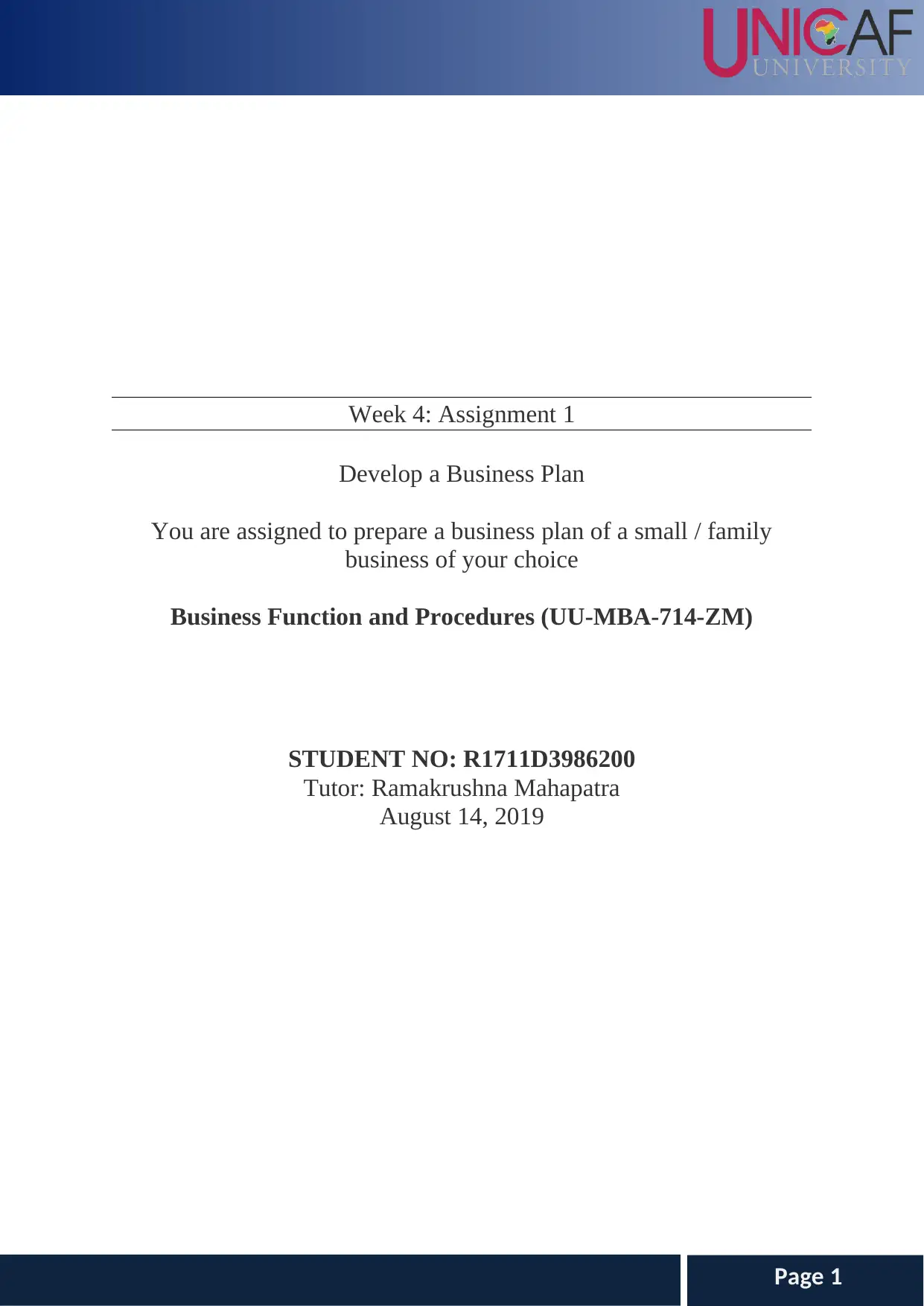
Page 1
Week 4: Assignment 1
Develop a Business Plan
You are assigned to prepare a business plan of a small / family
business of your choice
Business Function and Procedures (UU-MBA-714-ZM)
STUDENT NO: R1711D3986200
Tutor: Ramakrushna Mahapatra
August 14, 2019
Week 4: Assignment 1
Develop a Business Plan
You are assigned to prepare a business plan of a small / family
business of your choice
Business Function and Procedures (UU-MBA-714-ZM)
STUDENT NO: R1711D3986200
Tutor: Ramakrushna Mahapatra
August 14, 2019
Paraphrase This Document
Need a fresh take? Get an instant paraphrase of this document with our AI Paraphraser
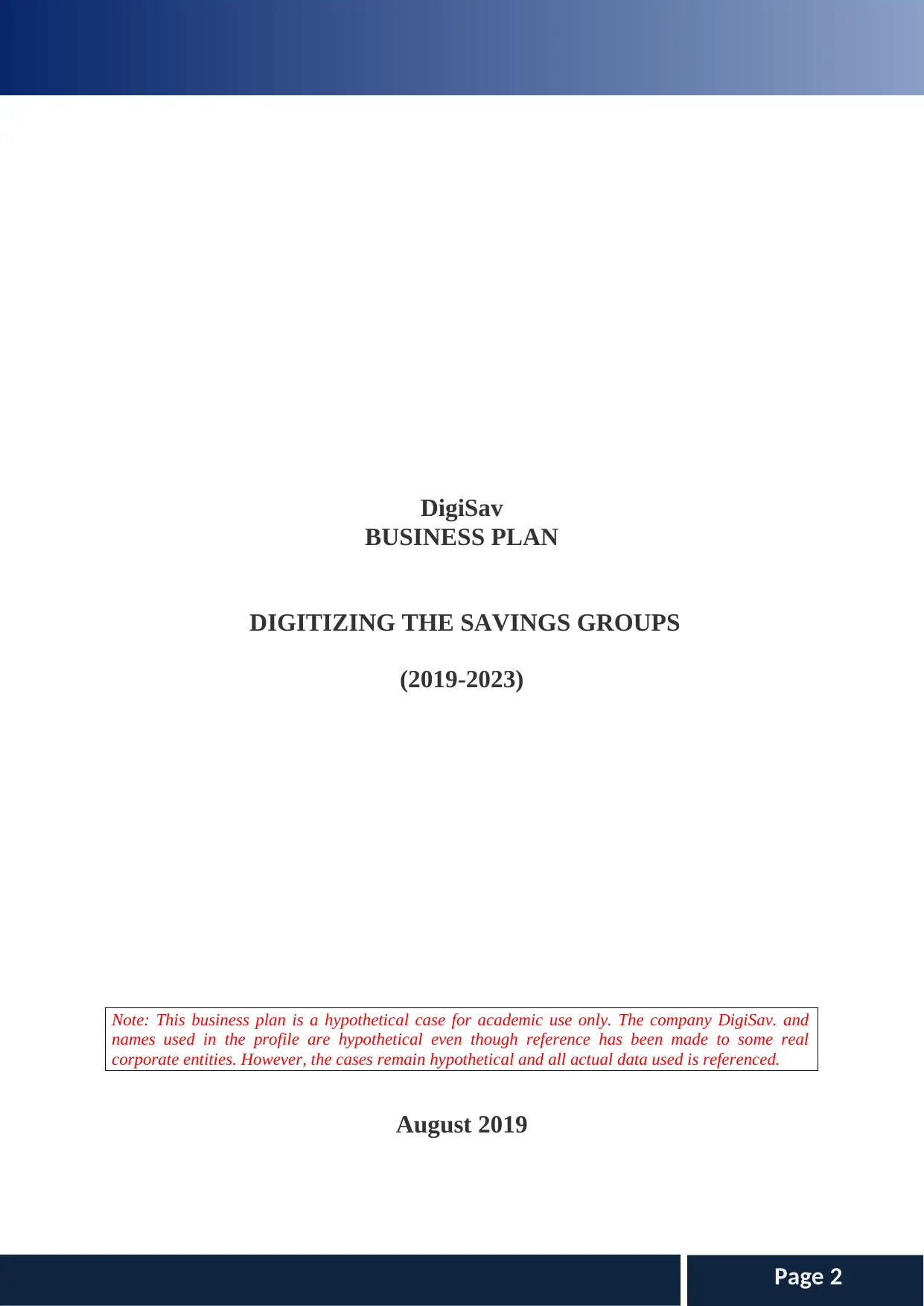
Page 2
DigiSav
BUSINESS PLAN
DIGITIZING THE SAVINGS GROUPS
(2019-2023)
Note: This business plan is a hypothetical case for academic use only. The company DigiSav. and
names used in the profile are hypothetical even though reference has been made to some real
corporate entities. However, the cases remain hypothetical and all actual data used is referenced.
August 2019
DigiSav
BUSINESS PLAN
DIGITIZING THE SAVINGS GROUPS
(2019-2023)
Note: This business plan is a hypothetical case for academic use only. The company DigiSav. and
names used in the profile are hypothetical even though reference has been made to some real
corporate entities. However, the cases remain hypothetical and all actual data used is referenced.
August 2019
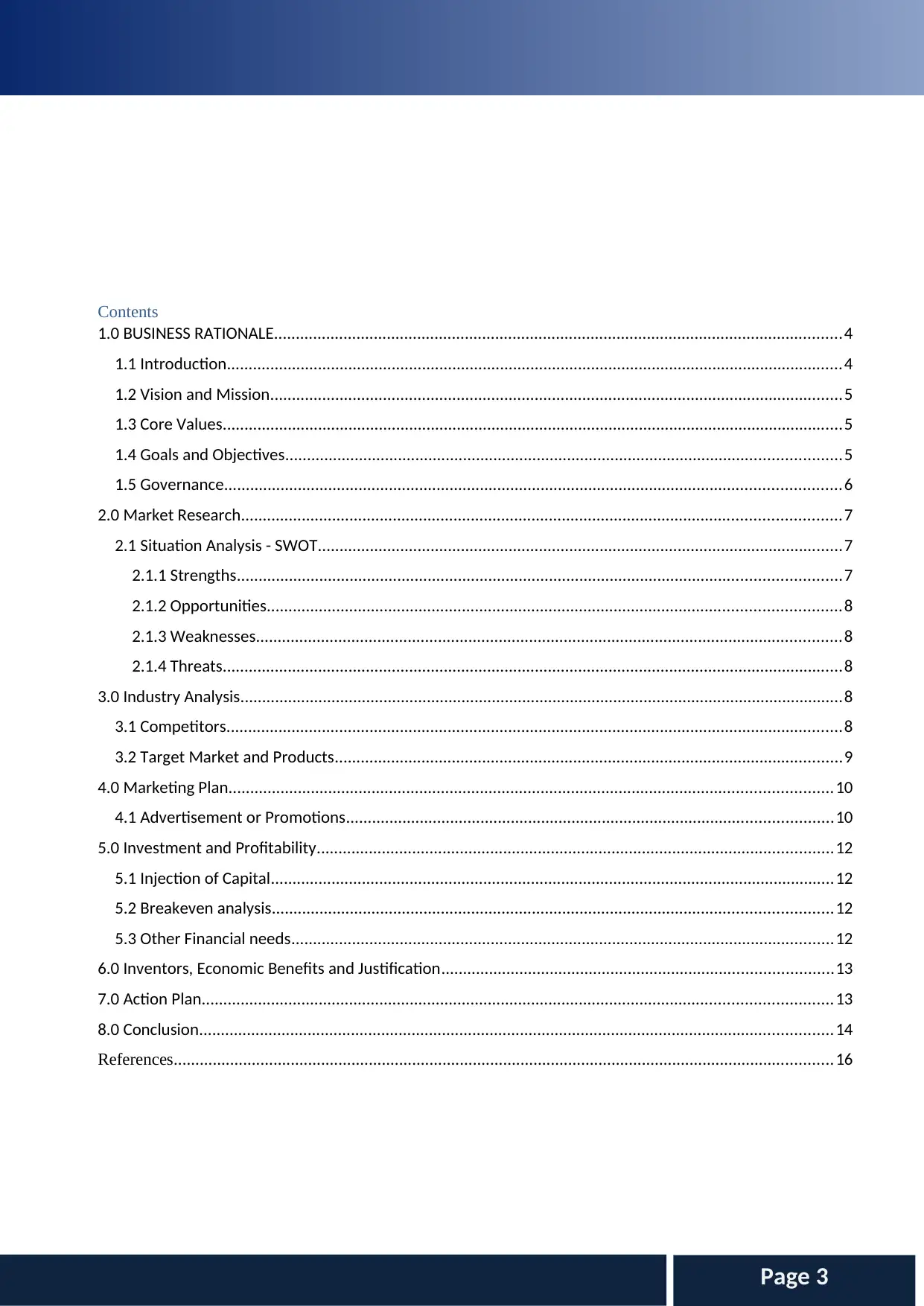
Page 3
Contents
1.0 BUSINESS RATIONALE...................................................................................................................................4
1.1 Introduction..............................................................................................................................................4
1.2 Vision and Mission....................................................................................................................................5
1.3 Core Values...............................................................................................................................................5
1.4 Goals and Objectives................................................................................................................................5
1.5 Governance..............................................................................................................................................6
2.0 Market Research..........................................................................................................................................7
2.1 Situation Analysis - SWOT.........................................................................................................................7
2.1.1 Strengths...........................................................................................................................................7
2.1.2 Opportunities....................................................................................................................................8
2.1.3 Weaknesses.......................................................................................................................................8
2.1.4 Threats...............................................................................................................................................8
3.0 Industry Analysis...........................................................................................................................................8
3.1 Competitors..............................................................................................................................................8
3.2 Target Market and Products.....................................................................................................................9
4.0 Marketing Plan...........................................................................................................................................10
4.1 Advertisement or Promotions................................................................................................................10
5.0 Investment and Profitability.......................................................................................................................12
5.1 Injection of Capital..................................................................................................................................12
5.2 Breakeven analysis.................................................................................................................................12
5.3 Other Financial needs.............................................................................................................................12
6.0 Inventors, Economic Benefits and Justification..........................................................................................13
7.0 Action Plan.................................................................................................................................................13
8.0 Conclusion..................................................................................................................................................14
References........................................................................................................................................................16
Contents
1.0 BUSINESS RATIONALE...................................................................................................................................4
1.1 Introduction..............................................................................................................................................4
1.2 Vision and Mission....................................................................................................................................5
1.3 Core Values...............................................................................................................................................5
1.4 Goals and Objectives................................................................................................................................5
1.5 Governance..............................................................................................................................................6
2.0 Market Research..........................................................................................................................................7
2.1 Situation Analysis - SWOT.........................................................................................................................7
2.1.1 Strengths...........................................................................................................................................7
2.1.2 Opportunities....................................................................................................................................8
2.1.3 Weaknesses.......................................................................................................................................8
2.1.4 Threats...............................................................................................................................................8
3.0 Industry Analysis...........................................................................................................................................8
3.1 Competitors..............................................................................................................................................8
3.2 Target Market and Products.....................................................................................................................9
4.0 Marketing Plan...........................................................................................................................................10
4.1 Advertisement or Promotions................................................................................................................10
5.0 Investment and Profitability.......................................................................................................................12
5.1 Injection of Capital..................................................................................................................................12
5.2 Breakeven analysis.................................................................................................................................12
5.3 Other Financial needs.............................................................................................................................12
6.0 Inventors, Economic Benefits and Justification..........................................................................................13
7.0 Action Plan.................................................................................................................................................13
8.0 Conclusion..................................................................................................................................................14
References........................................................................................................................................................16
⊘ This is a preview!⊘
Do you want full access?
Subscribe today to unlock all pages.

Trusted by 1+ million students worldwide
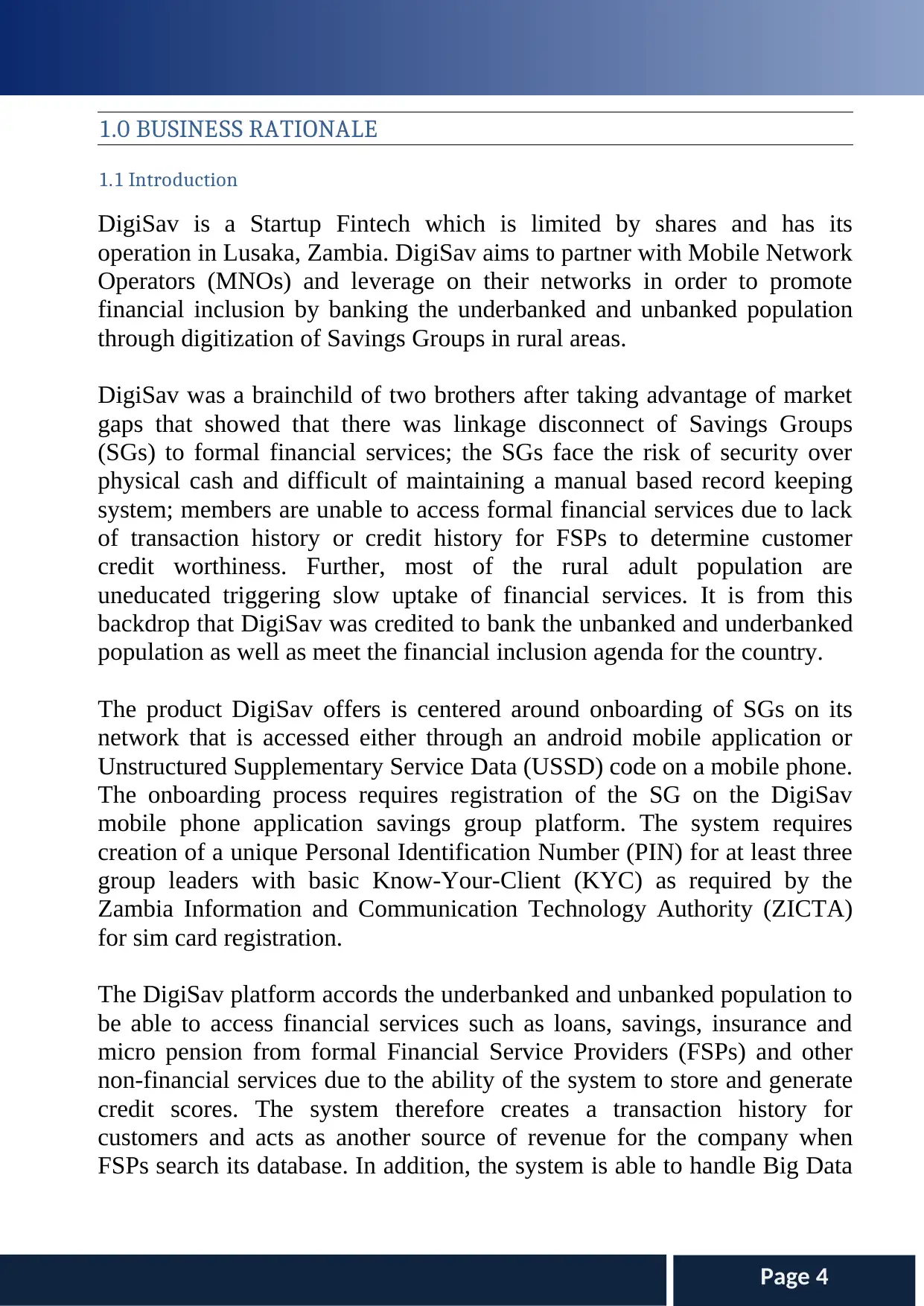
Page 4
1.0 BUSINESS RATIONALE
1.1 Introduction
DigiSav is a Startup Fintech which is limited by shares and has its
operation in Lusaka, Zambia. DigiSav aims to partner with Mobile Network
Operators (MNOs) and leverage on their networks in order to promote
financial inclusion by banking the underbanked and unbanked population
through digitization of Savings Groups in rural areas.
DigiSav was a brainchild of two brothers after taking advantage of market
gaps that showed that there was linkage disconnect of Savings Groups
(SGs) to formal financial services; the SGs face the risk of security over
physical cash and difficult of maintaining a manual based record keeping
system; members are unable to access formal financial services due to lack
of transaction history or credit history for FSPs to determine customer
credit worthiness. Further, most of the rural adult population are
uneducated triggering slow uptake of financial services. It is from this
backdrop that DigiSav was credited to bank the unbanked and underbanked
population as well as meet the financial inclusion agenda for the country.
The product DigiSav offers is centered around onboarding of SGs on its
network that is accessed either through an android mobile application or
Unstructured Supplementary Service Data (USSD) code on a mobile phone.
The onboarding process requires registration of the SG on the DigiSav
mobile phone application savings group platform. The system requires
creation of a unique Personal Identification Number (PIN) for at least three
group leaders with basic Know-Your-Client (KYC) as required by the
Zambia Information and Communication Technology Authority (ZICTA)
for sim card registration.
The DigiSav platform accords the underbanked and unbanked population to
be able to access financial services such as loans, savings, insurance and
micro pension from formal Financial Service Providers (FSPs) and other
non-financial services due to the ability of the system to store and generate
credit scores. The system therefore creates a transaction history for
customers and acts as another source of revenue for the company when
FSPs search its database. In addition, the system is able to handle Big Data
1.0 BUSINESS RATIONALE
1.1 Introduction
DigiSav is a Startup Fintech which is limited by shares and has its
operation in Lusaka, Zambia. DigiSav aims to partner with Mobile Network
Operators (MNOs) and leverage on their networks in order to promote
financial inclusion by banking the underbanked and unbanked population
through digitization of Savings Groups in rural areas.
DigiSav was a brainchild of two brothers after taking advantage of market
gaps that showed that there was linkage disconnect of Savings Groups
(SGs) to formal financial services; the SGs face the risk of security over
physical cash and difficult of maintaining a manual based record keeping
system; members are unable to access formal financial services due to lack
of transaction history or credit history for FSPs to determine customer
credit worthiness. Further, most of the rural adult population are
uneducated triggering slow uptake of financial services. It is from this
backdrop that DigiSav was credited to bank the unbanked and underbanked
population as well as meet the financial inclusion agenda for the country.
The product DigiSav offers is centered around onboarding of SGs on its
network that is accessed either through an android mobile application or
Unstructured Supplementary Service Data (USSD) code on a mobile phone.
The onboarding process requires registration of the SG on the DigiSav
mobile phone application savings group platform. The system requires
creation of a unique Personal Identification Number (PIN) for at least three
group leaders with basic Know-Your-Client (KYC) as required by the
Zambia Information and Communication Technology Authority (ZICTA)
for sim card registration.
The DigiSav platform accords the underbanked and unbanked population to
be able to access financial services such as loans, savings, insurance and
micro pension from formal Financial Service Providers (FSPs) and other
non-financial services due to the ability of the system to store and generate
credit scores. The system therefore creates a transaction history for
customers and acts as another source of revenue for the company when
FSPs search its database. In addition, the system is able to handle Big Data
Paraphrase This Document
Need a fresh take? Get an instant paraphrase of this document with our AI Paraphraser
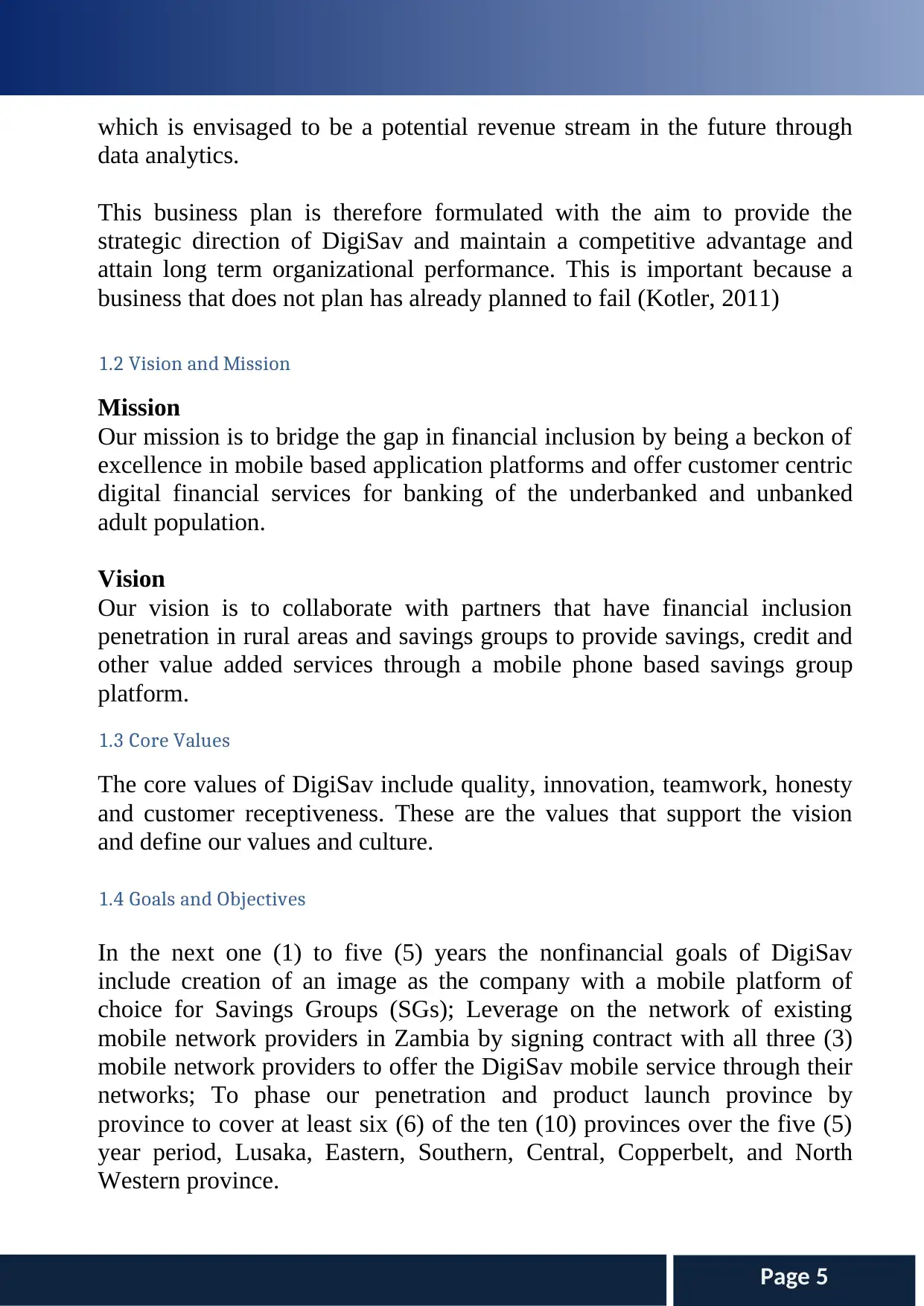
Page 5
which is envisaged to be a potential revenue stream in the future through
data analytics.
This business plan is therefore formulated with the aim to provide the
strategic direction of DigiSav and maintain a competitive advantage and
attain long term organizational performance. This is important because a
business that does not plan has already planned to fail (Kotler, 2011)
1.2 Vision and Mission
Mission
Our mission is to bridge the gap in financial inclusion by being a beckon of
excellence in mobile based application platforms and offer customer centric
digital financial services for banking of the underbanked and unbanked
adult population.
Vision
Our vision is to collaborate with partners that have financial inclusion
penetration in rural areas and savings groups to provide savings, credit and
other value added services through a mobile phone based savings group
platform.
1.3 Core Values
The core values of DigiSav include quality, innovation, teamwork, honesty
and customer receptiveness. These are the values that support the vision
and define our values and culture.
1.4 Goals and Objectives
In the next one (1) to five (5) years the nonfinancial goals of DigiSav
include creation of an image as the company with a mobile platform of
choice for Savings Groups (SGs); Leverage on the network of existing
mobile network providers in Zambia by signing contract with all three (3)
mobile network providers to offer the DigiSav mobile service through their
networks; To phase our penetration and product launch province by
province to cover at least six (6) of the ten (10) provinces over the five (5)
year period, Lusaka, Eastern, Southern, Central, Copperbelt, and North
Western province.
which is envisaged to be a potential revenue stream in the future through
data analytics.
This business plan is therefore formulated with the aim to provide the
strategic direction of DigiSav and maintain a competitive advantage and
attain long term organizational performance. This is important because a
business that does not plan has already planned to fail (Kotler, 2011)
1.2 Vision and Mission
Mission
Our mission is to bridge the gap in financial inclusion by being a beckon of
excellence in mobile based application platforms and offer customer centric
digital financial services for banking of the underbanked and unbanked
adult population.
Vision
Our vision is to collaborate with partners that have financial inclusion
penetration in rural areas and savings groups to provide savings, credit and
other value added services through a mobile phone based savings group
platform.
1.3 Core Values
The core values of DigiSav include quality, innovation, teamwork, honesty
and customer receptiveness. These are the values that support the vision
and define our values and culture.
1.4 Goals and Objectives
In the next one (1) to five (5) years the nonfinancial goals of DigiSav
include creation of an image as the company with a mobile platform of
choice for Savings Groups (SGs); Leverage on the network of existing
mobile network providers in Zambia by signing contract with all three (3)
mobile network providers to offer the DigiSav mobile service through their
networks; To phase our penetration and product launch province by
province to cover at least six (6) of the ten (10) provinces over the five (5)
year period, Lusaka, Eastern, Southern, Central, Copperbelt, and North
Western province.
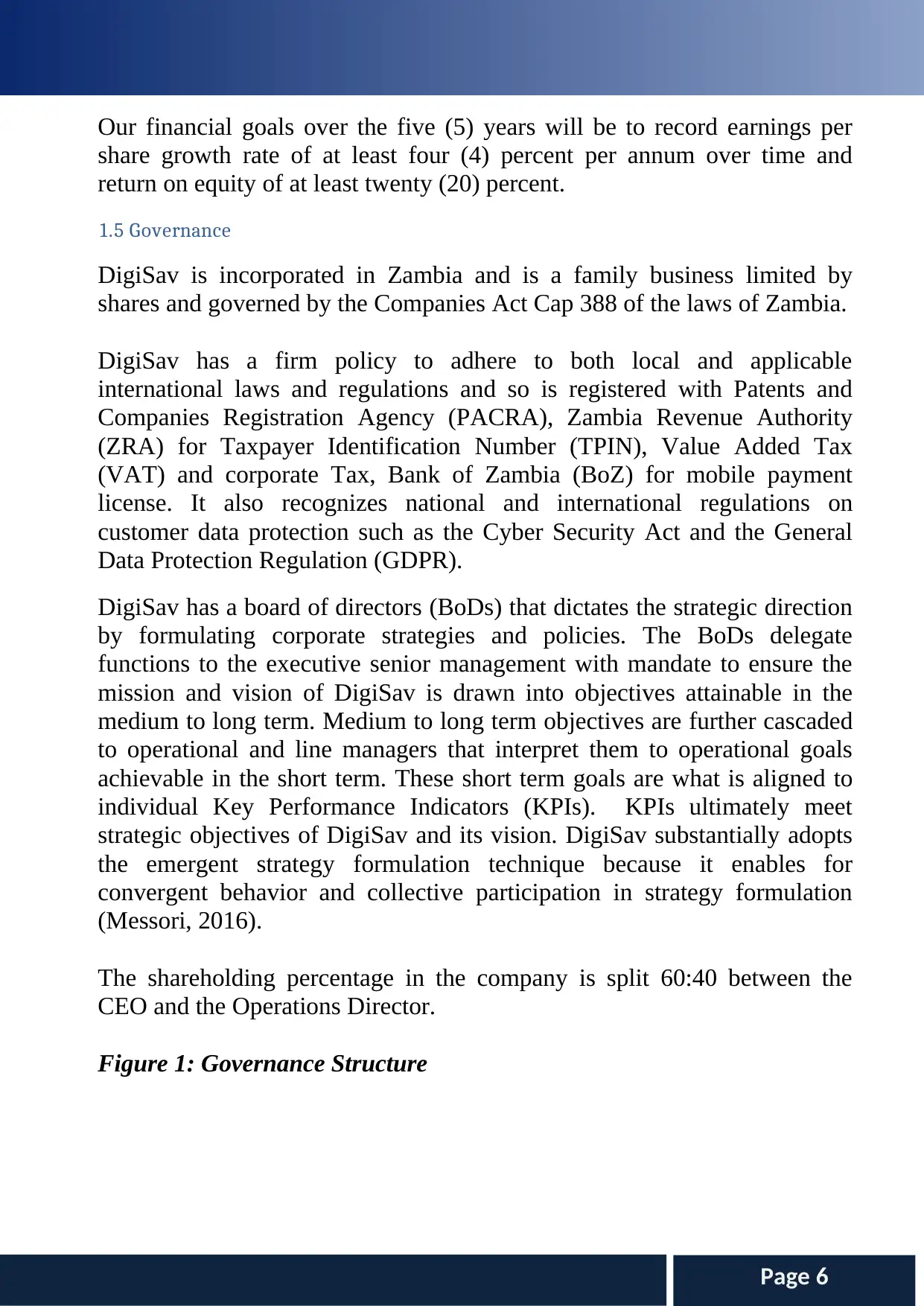
Page 6
Our financial goals over the five (5) years will be to record earnings per
share growth rate of at least four (4) percent per annum over time and
return on equity of at least twenty (20) percent.
1.5 Governance
DigiSav is incorporated in Zambia and is a family business limited by
shares and governed by the Companies Act Cap 388 of the laws of Zambia.
DigiSav has a firm policy to adhere to both local and applicable
international laws and regulations and so is registered with Patents and
Companies Registration Agency (PACRA), Zambia Revenue Authority
(ZRA) for Taxpayer Identification Number (TPIN), Value Added Tax
(VAT) and corporate Tax, Bank of Zambia (BoZ) for mobile payment
license. It also recognizes national and international regulations on
customer data protection such as the Cyber Security Act and the General
Data Protection Regulation (GDPR).
DigiSav has a board of directors (BoDs) that dictates the strategic direction
by formulating corporate strategies and policies. The BoDs delegate
functions to the executive senior management with mandate to ensure the
mission and vision of DigiSav is drawn into objectives attainable in the
medium to long term. Medium to long term objectives are further cascaded
to operational and line managers that interpret them to operational goals
achievable in the short term. These short term goals are what is aligned to
individual Key Performance Indicators (KPIs). KPIs ultimately meet
strategic objectives of DigiSav and its vision. DigiSav substantially adopts
the emergent strategy formulation technique because it enables for
convergent behavior and collective participation in strategy formulation
(Messori, 2016).
The shareholding percentage in the company is split 60:40 between the
CEO and the Operations Director.
Figure 1: Governance Structure
Our financial goals over the five (5) years will be to record earnings per
share growth rate of at least four (4) percent per annum over time and
return on equity of at least twenty (20) percent.
1.5 Governance
DigiSav is incorporated in Zambia and is a family business limited by
shares and governed by the Companies Act Cap 388 of the laws of Zambia.
DigiSav has a firm policy to adhere to both local and applicable
international laws and regulations and so is registered with Patents and
Companies Registration Agency (PACRA), Zambia Revenue Authority
(ZRA) for Taxpayer Identification Number (TPIN), Value Added Tax
(VAT) and corporate Tax, Bank of Zambia (BoZ) for mobile payment
license. It also recognizes national and international regulations on
customer data protection such as the Cyber Security Act and the General
Data Protection Regulation (GDPR).
DigiSav has a board of directors (BoDs) that dictates the strategic direction
by formulating corporate strategies and policies. The BoDs delegate
functions to the executive senior management with mandate to ensure the
mission and vision of DigiSav is drawn into objectives attainable in the
medium to long term. Medium to long term objectives are further cascaded
to operational and line managers that interpret them to operational goals
achievable in the short term. These short term goals are what is aligned to
individual Key Performance Indicators (KPIs). KPIs ultimately meet
strategic objectives of DigiSav and its vision. DigiSav substantially adopts
the emergent strategy formulation technique because it enables for
convergent behavior and collective participation in strategy formulation
(Messori, 2016).
The shareholding percentage in the company is split 60:40 between the
CEO and the Operations Director.
Figure 1: Governance Structure
⊘ This is a preview!⊘
Do you want full access?
Subscribe today to unlock all pages.

Trusted by 1+ million students worldwide
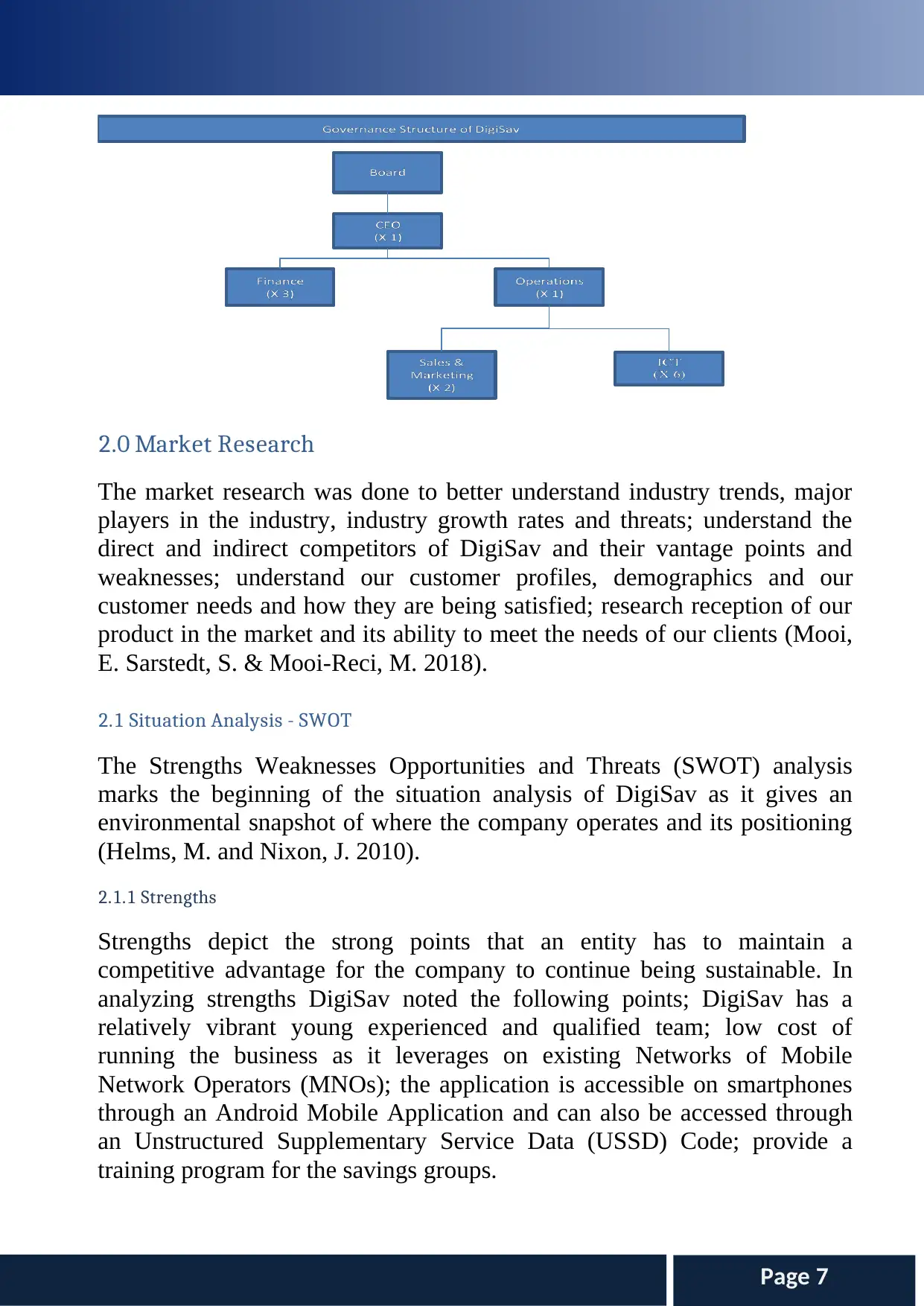
Page 7
2.0 Market Research
The market research was done to better understand industry trends, major
players in the industry, industry growth rates and threats; understand the
direct and indirect competitors of DigiSav and their vantage points and
weaknesses; understand our customer profiles, demographics and our
customer needs and how they are being satisfied; research reception of our
product in the market and its ability to meet the needs of our clients (Mooi,
E. Sarstedt, S. & Mooi-Reci, M. 2018).
2.1 Situation Analysis - SWOT
The Strengths Weaknesses Opportunities and Threats (SWOT) analysis
marks the beginning of the situation analysis of DigiSav as it gives an
environmental snapshot of where the company operates and its positioning
(Helms, M. and Nixon, J. 2010).
2.1.1 Strengths
Strengths depict the strong points that an entity has to maintain a
competitive advantage for the company to continue being sustainable. In
analyzing strengths DigiSav noted the following points; DigiSav has a
relatively vibrant young experienced and qualified team; low cost of
running the business as it leverages on existing Networks of Mobile
Network Operators (MNOs); the application is accessible on smartphones
through an Android Mobile Application and can also be accessed through
an Unstructured Supplementary Service Data (USSD) Code; provide a
training program for the savings groups.
2.0 Market Research
The market research was done to better understand industry trends, major
players in the industry, industry growth rates and threats; understand the
direct and indirect competitors of DigiSav and their vantage points and
weaknesses; understand our customer profiles, demographics and our
customer needs and how they are being satisfied; research reception of our
product in the market and its ability to meet the needs of our clients (Mooi,
E. Sarstedt, S. & Mooi-Reci, M. 2018).
2.1 Situation Analysis - SWOT
The Strengths Weaknesses Opportunities and Threats (SWOT) analysis
marks the beginning of the situation analysis of DigiSav as it gives an
environmental snapshot of where the company operates and its positioning
(Helms, M. and Nixon, J. 2010).
2.1.1 Strengths
Strengths depict the strong points that an entity has to maintain a
competitive advantage for the company to continue being sustainable. In
analyzing strengths DigiSav noted the following points; DigiSav has a
relatively vibrant young experienced and qualified team; low cost of
running the business as it leverages on existing Networks of Mobile
Network Operators (MNOs); the application is accessible on smartphones
through an Android Mobile Application and can also be accessed through
an Unstructured Supplementary Service Data (USSD) Code; provide a
training program for the savings groups.
Paraphrase This Document
Need a fresh take? Get an instant paraphrase of this document with our AI Paraphraser
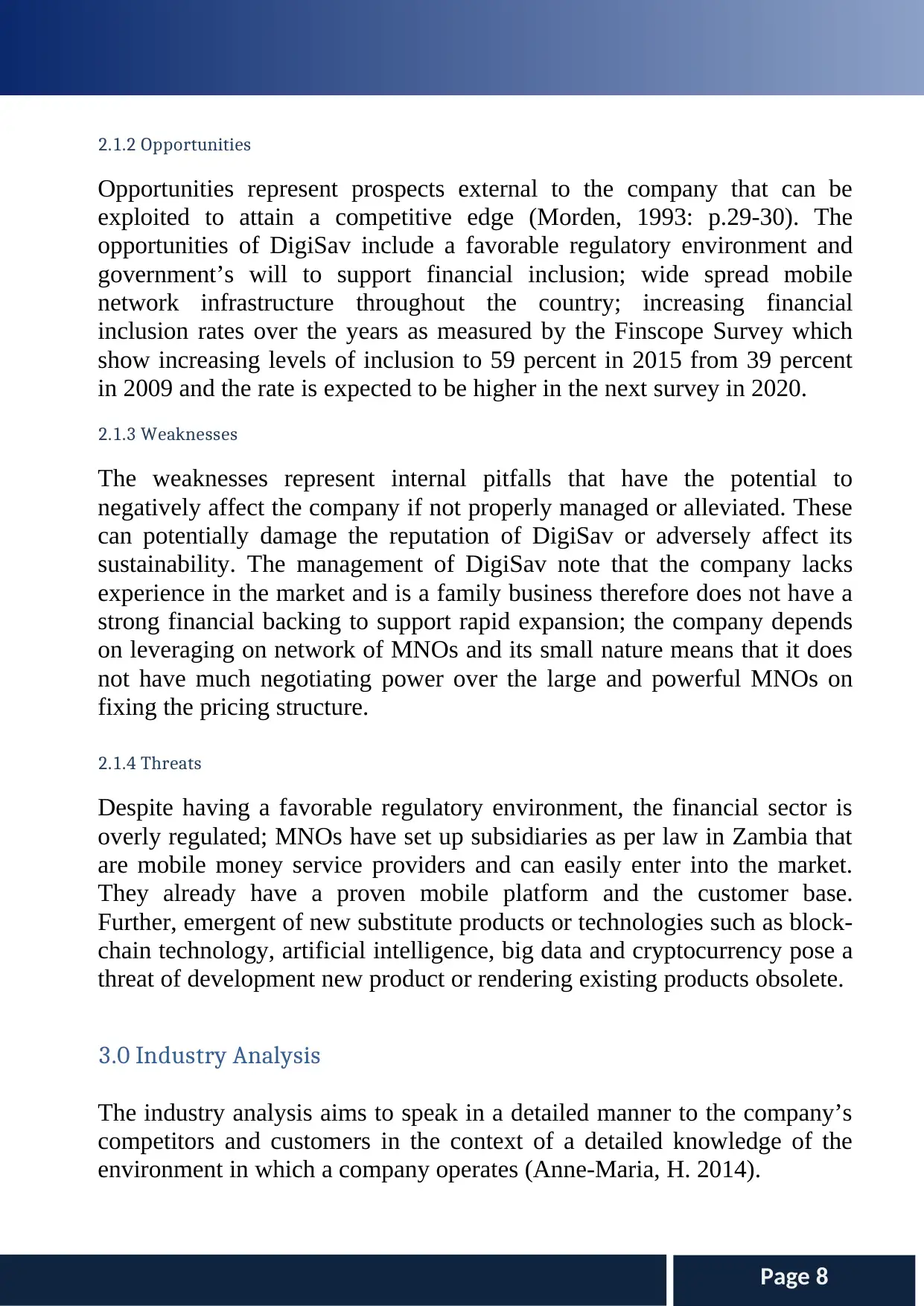
Page 8
2.1.2 Opportunities
Opportunities represent prospects external to the company that can be
exploited to attain a competitive edge (Morden, 1993: p.29-30). The
opportunities of DigiSav include a favorable regulatory environment and
government’s will to support financial inclusion; wide spread mobile
network infrastructure throughout the country; increasing financial
inclusion rates over the years as measured by the Finscope Survey which
show increasing levels of inclusion to 59 percent in 2015 from 39 percent
in 2009 and the rate is expected to be higher in the next survey in 2020.
2.1.3 Weaknesses
The weaknesses represent internal pitfalls that have the potential to
negatively affect the company if not properly managed or alleviated. These
can potentially damage the reputation of DigiSav or adversely affect its
sustainability. The management of DigiSav note that the company lacks
experience in the market and is a family business therefore does not have a
strong financial backing to support rapid expansion; the company depends
on leveraging on network of MNOs and its small nature means that it does
not have much negotiating power over the large and powerful MNOs on
fixing the pricing structure.
2.1.4 Threats
Despite having a favorable regulatory environment, the financial sector is
overly regulated; MNOs have set up subsidiaries as per law in Zambia that
are mobile money service providers and can easily enter into the market.
They already have a proven mobile platform and the customer base.
Further, emergent of new substitute products or technologies such as block-
chain technology, artificial intelligence, big data and cryptocurrency pose a
threat of development new product or rendering existing products obsolete.
3.0 Industry Analysis
The industry analysis aims to speak in a detailed manner to the company’s
competitors and customers in the context of a detailed knowledge of the
environment in which a company operates (Anne-Maria, H. 2014).
2.1.2 Opportunities
Opportunities represent prospects external to the company that can be
exploited to attain a competitive edge (Morden, 1993: p.29-30). The
opportunities of DigiSav include a favorable regulatory environment and
government’s will to support financial inclusion; wide spread mobile
network infrastructure throughout the country; increasing financial
inclusion rates over the years as measured by the Finscope Survey which
show increasing levels of inclusion to 59 percent in 2015 from 39 percent
in 2009 and the rate is expected to be higher in the next survey in 2020.
2.1.3 Weaknesses
The weaknesses represent internal pitfalls that have the potential to
negatively affect the company if not properly managed or alleviated. These
can potentially damage the reputation of DigiSav or adversely affect its
sustainability. The management of DigiSav note that the company lacks
experience in the market and is a family business therefore does not have a
strong financial backing to support rapid expansion; the company depends
on leveraging on network of MNOs and its small nature means that it does
not have much negotiating power over the large and powerful MNOs on
fixing the pricing structure.
2.1.4 Threats
Despite having a favorable regulatory environment, the financial sector is
overly regulated; MNOs have set up subsidiaries as per law in Zambia that
are mobile money service providers and can easily enter into the market.
They already have a proven mobile platform and the customer base.
Further, emergent of new substitute products or technologies such as block-
chain technology, artificial intelligence, big data and cryptocurrency pose a
threat of development new product or rendering existing products obsolete.
3.0 Industry Analysis
The industry analysis aims to speak in a detailed manner to the company’s
competitors and customers in the context of a detailed knowledge of the
environment in which a company operates (Anne-Maria, H. 2014).
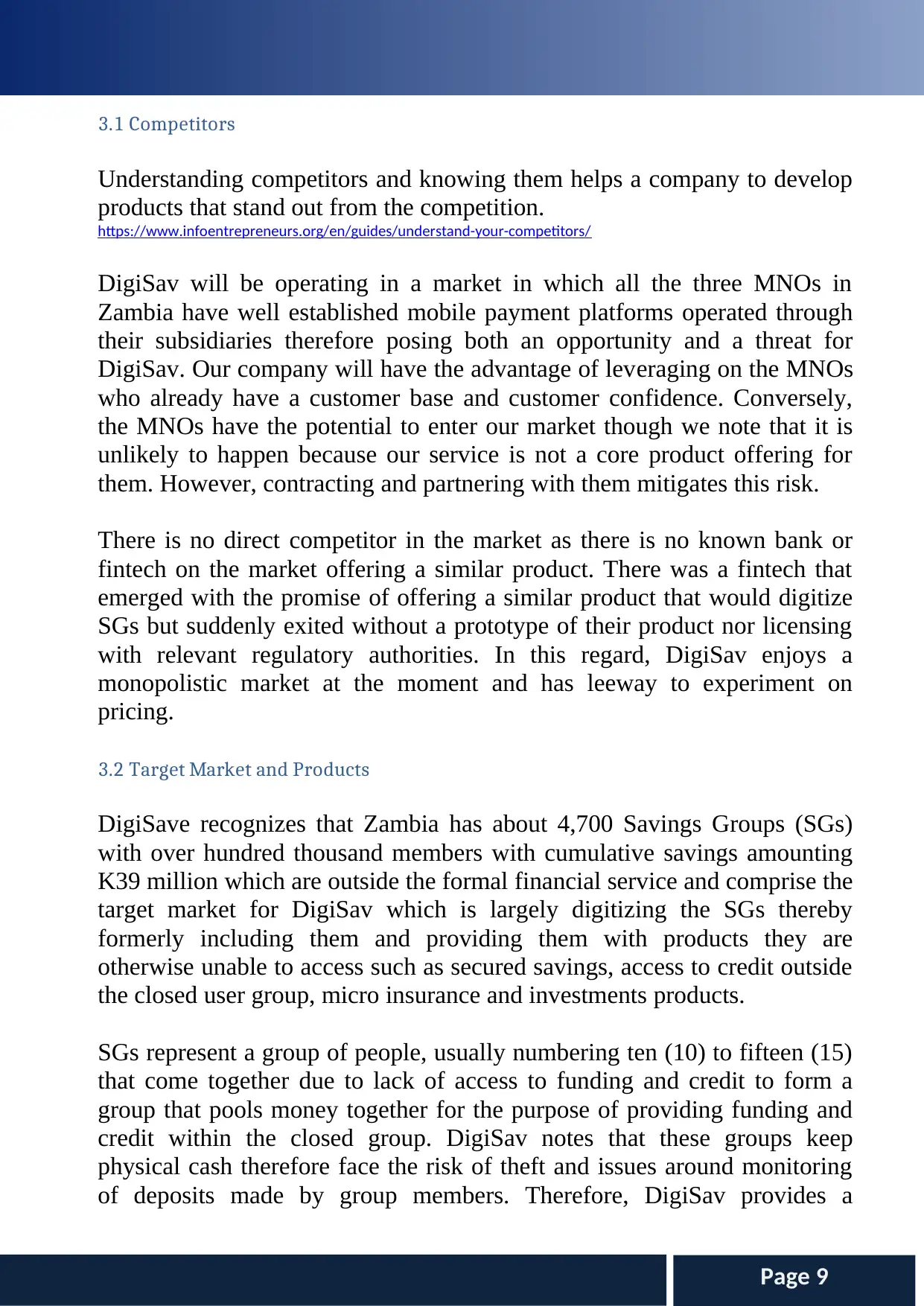
Page 9
3.1 Competitors
Understanding competitors and knowing them helps a company to develop
products that stand out from the competition.
https://www.infoentrepreneurs.org/en/guides/understand-your-competitors/
DigiSav will be operating in a market in which all the three MNOs in
Zambia have well established mobile payment platforms operated through
their subsidiaries therefore posing both an opportunity and a threat for
DigiSav. Our company will have the advantage of leveraging on the MNOs
who already have a customer base and customer confidence. Conversely,
the MNOs have the potential to enter our market though we note that it is
unlikely to happen because our service is not a core product offering for
them. However, contracting and partnering with them mitigates this risk.
There is no direct competitor in the market as there is no known bank or
fintech on the market offering a similar product. There was a fintech that
emerged with the promise of offering a similar product that would digitize
SGs but suddenly exited without a prototype of their product nor licensing
with relevant regulatory authorities. In this regard, DigiSav enjoys a
monopolistic market at the moment and has leeway to experiment on
pricing.
3.2 Target Market and Products
DigiSave recognizes that Zambia has about 4,700 Savings Groups (SGs)
with over hundred thousand members with cumulative savings amounting
K39 million which are outside the formal financial service and comprise the
target market for DigiSav which is largely digitizing the SGs thereby
formerly including them and providing them with products they are
otherwise unable to access such as secured savings, access to credit outside
the closed user group, micro insurance and investments products.
SGs represent a group of people, usually numbering ten (10) to fifteen (15)
that come together due to lack of access to funding and credit to form a
group that pools money together for the purpose of providing funding and
credit within the closed group. DigiSav notes that these groups keep
physical cash therefore face the risk of theft and issues around monitoring
of deposits made by group members. Therefore, DigiSav provides a
3.1 Competitors
Understanding competitors and knowing them helps a company to develop
products that stand out from the competition.
https://www.infoentrepreneurs.org/en/guides/understand-your-competitors/
DigiSav will be operating in a market in which all the three MNOs in
Zambia have well established mobile payment platforms operated through
their subsidiaries therefore posing both an opportunity and a threat for
DigiSav. Our company will have the advantage of leveraging on the MNOs
who already have a customer base and customer confidence. Conversely,
the MNOs have the potential to enter our market though we note that it is
unlikely to happen because our service is not a core product offering for
them. However, contracting and partnering with them mitigates this risk.
There is no direct competitor in the market as there is no known bank or
fintech on the market offering a similar product. There was a fintech that
emerged with the promise of offering a similar product that would digitize
SGs but suddenly exited without a prototype of their product nor licensing
with relevant regulatory authorities. In this regard, DigiSav enjoys a
monopolistic market at the moment and has leeway to experiment on
pricing.
3.2 Target Market and Products
DigiSave recognizes that Zambia has about 4,700 Savings Groups (SGs)
with over hundred thousand members with cumulative savings amounting
K39 million which are outside the formal financial service and comprise the
target market for DigiSav which is largely digitizing the SGs thereby
formerly including them and providing them with products they are
otherwise unable to access such as secured savings, access to credit outside
the closed user group, micro insurance and investments products.
SGs represent a group of people, usually numbering ten (10) to fifteen (15)
that come together due to lack of access to funding and credit to form a
group that pools money together for the purpose of providing funding and
credit within the closed group. DigiSav notes that these groups keep
physical cash therefore face the risk of theft and issues around monitoring
of deposits made by group members. Therefore, DigiSav provides a
⊘ This is a preview!⊘
Do you want full access?
Subscribe today to unlock all pages.

Trusted by 1+ million students worldwide
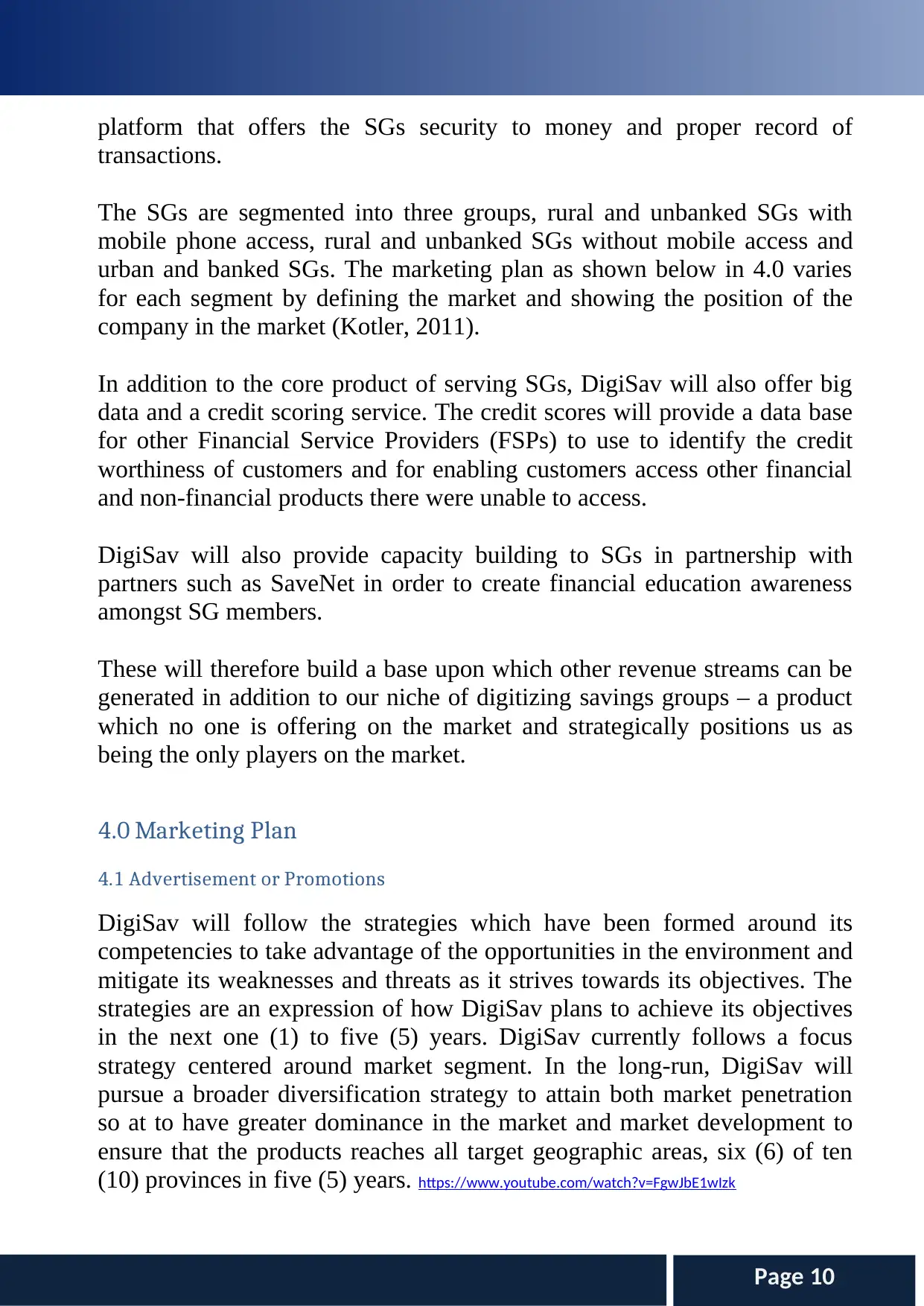
Page 10
platform that offers the SGs security to money and proper record of
transactions.
The SGs are segmented into three groups, rural and unbanked SGs with
mobile phone access, rural and unbanked SGs without mobile access and
urban and banked SGs. The marketing plan as shown below in 4.0 varies
for each segment by defining the market and showing the position of the
company in the market (Kotler, 2011).
In addition to the core product of serving SGs, DigiSav will also offer big
data and a credit scoring service. The credit scores will provide a data base
for other Financial Service Providers (FSPs) to use to identify the credit
worthiness of customers and for enabling customers access other financial
and non-financial products there were unable to access.
DigiSav will also provide capacity building to SGs in partnership with
partners such as SaveNet in order to create financial education awareness
amongst SG members.
These will therefore build a base upon which other revenue streams can be
generated in addition to our niche of digitizing savings groups – a product
which no one is offering on the market and strategically positions us as
being the only players on the market.
4.0 Marketing Plan
4.1 Advertisement or Promotions
DigiSav will follow the strategies which have been formed around its
competencies to take advantage of the opportunities in the environment and
mitigate its weaknesses and threats as it strives towards its objectives. The
strategies are an expression of how DigiSav plans to achieve its objectives
in the next one (1) to five (5) years. DigiSav currently follows a focus
strategy centered around market segment. In the long-run, DigiSav will
pursue a broader diversification strategy to attain both market penetration
so at to have greater dominance in the market and market development to
ensure that the products reaches all target geographic areas, six (6) of ten
(10) provinces in five (5) years. https://www.youtube.com/watch?v=FgwJbE1wIzk
platform that offers the SGs security to money and proper record of
transactions.
The SGs are segmented into three groups, rural and unbanked SGs with
mobile phone access, rural and unbanked SGs without mobile access and
urban and banked SGs. The marketing plan as shown below in 4.0 varies
for each segment by defining the market and showing the position of the
company in the market (Kotler, 2011).
In addition to the core product of serving SGs, DigiSav will also offer big
data and a credit scoring service. The credit scores will provide a data base
for other Financial Service Providers (FSPs) to use to identify the credit
worthiness of customers and for enabling customers access other financial
and non-financial products there were unable to access.
DigiSav will also provide capacity building to SGs in partnership with
partners such as SaveNet in order to create financial education awareness
amongst SG members.
These will therefore build a base upon which other revenue streams can be
generated in addition to our niche of digitizing savings groups – a product
which no one is offering on the market and strategically positions us as
being the only players on the market.
4.0 Marketing Plan
4.1 Advertisement or Promotions
DigiSav will follow the strategies which have been formed around its
competencies to take advantage of the opportunities in the environment and
mitigate its weaknesses and threats as it strives towards its objectives. The
strategies are an expression of how DigiSav plans to achieve its objectives
in the next one (1) to five (5) years. DigiSav currently follows a focus
strategy centered around market segment. In the long-run, DigiSav will
pursue a broader diversification strategy to attain both market penetration
so at to have greater dominance in the market and market development to
ensure that the products reaches all target geographic areas, six (6) of ten
(10) provinces in five (5) years. https://www.youtube.com/watch?v=FgwJbE1wIzk
Paraphrase This Document
Need a fresh take? Get an instant paraphrase of this document with our AI Paraphraser
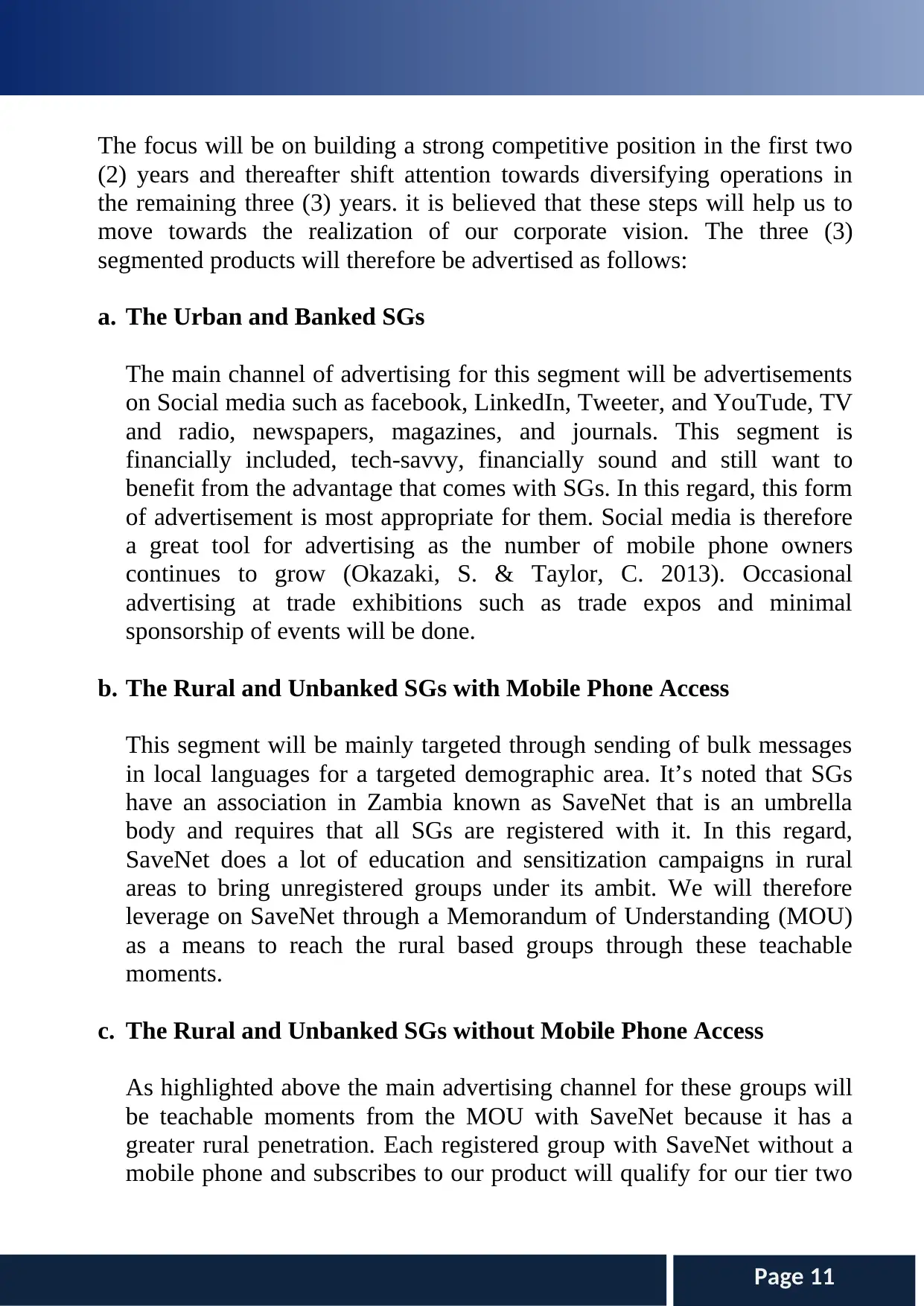
Page 11
The focus will be on building a strong competitive position in the first two
(2) years and thereafter shift attention towards diversifying operations in
the remaining three (3) years. it is believed that these steps will help us to
move towards the realization of our corporate vision. The three (3)
segmented products will therefore be advertised as follows:
a. The Urban and Banked SGs
The main channel of advertising for this segment will be advertisements
on Social media such as facebook, LinkedIn, Tweeter, and YouTude, TV
and radio, newspapers, magazines, and journals. This segment is
financially included, tech-savvy, financially sound and still want to
benefit from the advantage that comes with SGs. In this regard, this form
of advertisement is most appropriate for them. Social media is therefore
a great tool for advertising as the number of mobile phone owners
continues to grow (Okazaki, S. & Taylor, C. 2013). Occasional
advertising at trade exhibitions such as trade expos and minimal
sponsorship of events will be done.
b. The Rural and Unbanked SGs with Mobile Phone Access
This segment will be mainly targeted through sending of bulk messages
in local languages for a targeted demographic area. It’s noted that SGs
have an association in Zambia known as SaveNet that is an umbrella
body and requires that all SGs are registered with it. In this regard,
SaveNet does a lot of education and sensitization campaigns in rural
areas to bring unregistered groups under its ambit. We will therefore
leverage on SaveNet through a Memorandum of Understanding (MOU)
as a means to reach the rural based groups through these teachable
moments.
c. The Rural and Unbanked SGs without Mobile Phone Access
As highlighted above the main advertising channel for these groups will
be teachable moments from the MOU with SaveNet because it has a
greater rural penetration. Each registered group with SaveNet without a
mobile phone and subscribes to our product will qualify for our tier two
The focus will be on building a strong competitive position in the first two
(2) years and thereafter shift attention towards diversifying operations in
the remaining three (3) years. it is believed that these steps will help us to
move towards the realization of our corporate vision. The three (3)
segmented products will therefore be advertised as follows:
a. The Urban and Banked SGs
The main channel of advertising for this segment will be advertisements
on Social media such as facebook, LinkedIn, Tweeter, and YouTude, TV
and radio, newspapers, magazines, and journals. This segment is
financially included, tech-savvy, financially sound and still want to
benefit from the advantage that comes with SGs. In this regard, this form
of advertisement is most appropriate for them. Social media is therefore
a great tool for advertising as the number of mobile phone owners
continues to grow (Okazaki, S. & Taylor, C. 2013). Occasional
advertising at trade exhibitions such as trade expos and minimal
sponsorship of events will be done.
b. The Rural and Unbanked SGs with Mobile Phone Access
This segment will be mainly targeted through sending of bulk messages
in local languages for a targeted demographic area. It’s noted that SGs
have an association in Zambia known as SaveNet that is an umbrella
body and requires that all SGs are registered with it. In this regard,
SaveNet does a lot of education and sensitization campaigns in rural
areas to bring unregistered groups under its ambit. We will therefore
leverage on SaveNet through a Memorandum of Understanding (MOU)
as a means to reach the rural based groups through these teachable
moments.
c. The Rural and Unbanked SGs without Mobile Phone Access
As highlighted above the main advertising channel for these groups will
be teachable moments from the MOU with SaveNet because it has a
greater rural penetration. Each registered group with SaveNet without a
mobile phone and subscribes to our product will qualify for our tier two
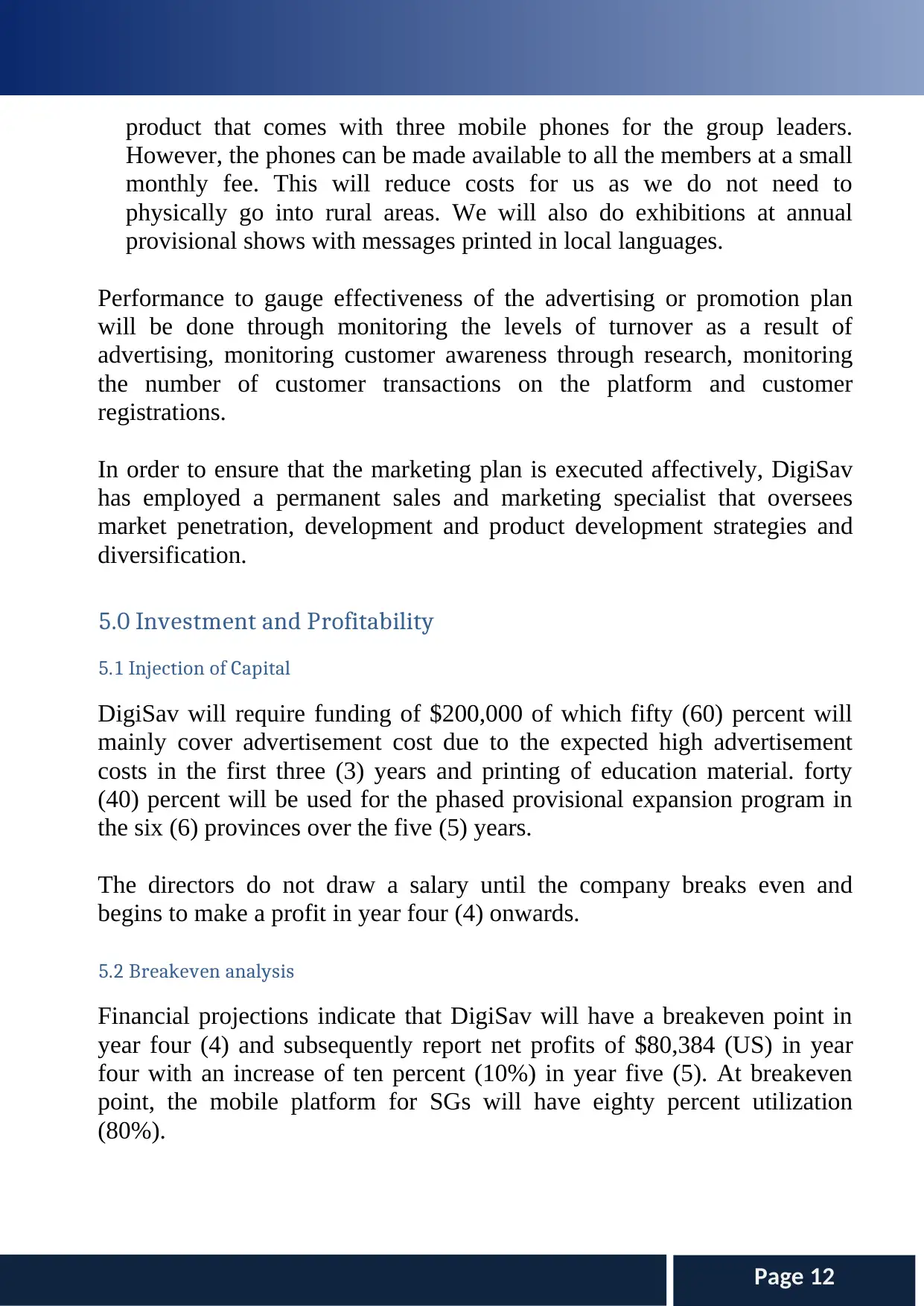
Page 12
product that comes with three mobile phones for the group leaders.
However, the phones can be made available to all the members at a small
monthly fee. This will reduce costs for us as we do not need to
physically go into rural areas. We will also do exhibitions at annual
provisional shows with messages printed in local languages.
Performance to gauge effectiveness of the advertising or promotion plan
will be done through monitoring the levels of turnover as a result of
advertising, monitoring customer awareness through research, monitoring
the number of customer transactions on the platform and customer
registrations.
In order to ensure that the marketing plan is executed affectively, DigiSav
has employed a permanent sales and marketing specialist that oversees
market penetration, development and product development strategies and
diversification.
5.0 Investment and Profitability
5.1 Injection of Capital
DigiSav will require funding of $200,000 of which fifty (60) percent will
mainly cover advertisement cost due to the expected high advertisement
costs in the first three (3) years and printing of education material. forty
(40) percent will be used for the phased provisional expansion program in
the six (6) provinces over the five (5) years.
The directors do not draw a salary until the company breaks even and
begins to make a profit in year four (4) onwards.
5.2 Breakeven analysis
Financial projections indicate that DigiSav will have a breakeven point in
year four (4) and subsequently report net profits of $80,384 (US) in year
four with an increase of ten percent (10%) in year five (5). At breakeven
point, the mobile platform for SGs will have eighty percent utilization
(80%).
product that comes with three mobile phones for the group leaders.
However, the phones can be made available to all the members at a small
monthly fee. This will reduce costs for us as we do not need to
physically go into rural areas. We will also do exhibitions at annual
provisional shows with messages printed in local languages.
Performance to gauge effectiveness of the advertising or promotion plan
will be done through monitoring the levels of turnover as a result of
advertising, monitoring customer awareness through research, monitoring
the number of customer transactions on the platform and customer
registrations.
In order to ensure that the marketing plan is executed affectively, DigiSav
has employed a permanent sales and marketing specialist that oversees
market penetration, development and product development strategies and
diversification.
5.0 Investment and Profitability
5.1 Injection of Capital
DigiSav will require funding of $200,000 of which fifty (60) percent will
mainly cover advertisement cost due to the expected high advertisement
costs in the first three (3) years and printing of education material. forty
(40) percent will be used for the phased provisional expansion program in
the six (6) provinces over the five (5) years.
The directors do not draw a salary until the company breaks even and
begins to make a profit in year four (4) onwards.
5.2 Breakeven analysis
Financial projections indicate that DigiSav will have a breakeven point in
year four (4) and subsequently report net profits of $80,384 (US) in year
four with an increase of ten percent (10%) in year five (5). At breakeven
point, the mobile platform for SGs will have eighty percent utilization
(80%).
⊘ This is a preview!⊘
Do you want full access?
Subscribe today to unlock all pages.

Trusted by 1+ million students worldwide
1 out of 16
Your All-in-One AI-Powered Toolkit for Academic Success.
+13062052269
info@desklib.com
Available 24*7 on WhatsApp / Email
![[object Object]](/_next/static/media/star-bottom.7253800d.svg)
Unlock your academic potential
Copyright © 2020–2025 A2Z Services. All Rights Reserved. Developed and managed by ZUCOL.

